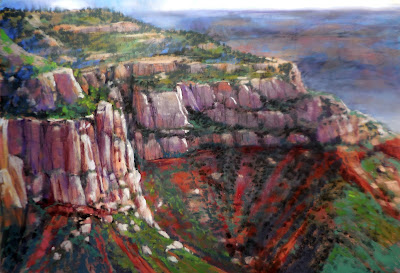Traveling from Sequoia to Yosemite, we were looking forward to a 4+ rated RV park on the banks of a bubbling river with blossoming flowers - according to the amazing website description. What we found when we arrived was a small strip of land on the edge of town wedged between an industrial park and a trailer storage area. Yes, there was a stream-like "river" that reminded Doug of the Little Calument River near Gary, Indiana, which used to periodically catch fire. Needless to say, we quickly moved to another campground.
Although the new RV park was beautiful, with rolling hills and a quiet, secluded spot for our trailer, we immediately noticed how extremely dry and brown the landscape was due to the four year California drought. This was our first exposure to the severity of the drought, although we're sure it won't be the last. On our second day, there was a forest fire in the hills of Oakhurst, just outside Yosemite. It lit up a hundred acres and filled the air with smoke. Specially trained firefighters responded and were able to get the fire under control in one day.
Unlike the first RV park, Yosemite did not disappoint. Yosemite is the grand-daddy of all the National Parks. It was the first land preserved by the United States government, set aside by Congress and given to California as the first State Park. Later, after Yellowstone became the first National Park, Yosemite also became a National Park. The Mariposa Grove of Sequoias, next to the Yosemite Valley, was added as part of the park later on. The US Calgary and Buffalo Soldiers operated and preserved the park until the National Park Service was formed.
The major attraction of Yosemite is the Yosemite Valley. The Merced River flows across the valley's flat floor at an elevation of 4,000 ft. above sea level. The valley is surrounded by steep, almost vertical cliffs soaring up another 3,000 ft. on each side.
In the late 1800's, there was a debate about how this valley was formed. Geologists of the day believed a great rift in the earth caused the valley floor to drop, creating the sheer granite walls with rivers dropping over the edge as waterfalls. John Muir, a famous conservationist, maintained that it was caused by powerful glaciers removing rock. He went on to say that the sheer walls were formed because they were solid granite and could withstand eons of erosion after glaciers removed the debris on the valley floor. It turns out John Muir was correct. It became a narrow valley with multiple waterfalls tumbling over the granite walls.
The trip to the valley takes over an hour, and after going through a tunnel, visitors are greeted by a stunning view of the valley. We have included a photo of this view above. Unfortunately, due to the drought and lack of winter snow in the higher altitudes, the falls are only flowing at about 1/3 their usual capacity and some of the smaller ones are expected to dry up during August. But even with the drought, the valley is impressive.
During our time at Yosemite, Doug taught a workshop. He did a number of paintings both at the Merced River, the cliffs and waterfalls. The paintings shown below include El Capitan, Merced River rapids and the Upper Falls.
To see all of Doug's 2015 National Park Tour Paintings, Click here:
http://www.dougtweddale.com/#!blank/c1hp2

































